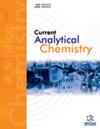用于检测前列腺癌潜在生物标记物肌氨酸的比色和电化学传感器:综述
IF 1.7
4区 化学
Q3 CHEMISTRY, ANALYTICAL
引用次数: 0
摘要
:肌氨酸目前被确定为前列腺癌的潜在生物标志物。它是甘氨酸的正甲基衍生物,天然存在于肌肉和人体组织中。研究表明,前列腺癌治疗的延误往往是由于无法在早期阶段进行诊断。此外,肌氨酸浓度升高的血浆和尿液样本显示这种癌症发展的可能性较高,因此将其作为生物标记物是安全的。因此,肌氨酸生物传感器可用于这种癌症的早期检测。因此,我们在本综述中讨论了用于检测肌氨酸的各类生物传感器。综述包括对生物传感器工作原理的概述,以及对所用方法的讨论,从传统色谱法到基于纳米技术的专用生物传感器。其中包含了从尿液和血液样本中检测肌氨酸的各种技术。我们还根据使用的材料、采用的技术、检测限(LOD)、线性范围、灵敏度和成本,对不同的肌氨酸检测报告进行了批判性评估。我们认为,这篇综述的新颖之处在于提供了现有进展的远景及其复杂的细节特征,从而促进了前列腺癌生物传感器的进一步发展。本文章由计算机程序翻译,如有差异,请以英文原文为准。
Colorimetric and Electrochemical Sensors for the Detection of Sarcosine, A potential Biomarker for Prostate Cancer: A Review
: Sarcosine is currently identified as a potential biomarker for prostate cancer. It is n-methyl derivative of glycine, which is naturally present in muscle and body tissues. Studies indicate that a delay in the treatment of prostate cancer is often due to its diagnosis not being possible at earlier stages. Also, plasma and urine samples with increased sarcosine concentration exhibit a higher probability of this cancer development, therefore, it is safe to proceed with them as biomarkers. Correspondingly, a sarcosine biosensor can be used for early detection of this cancer. Driven by this, in this review, we have discussed various types of biosensors for the detection of sarcosine. The review includes an overview of biosensors with their working principle, and discussion of the methodologies used, starting from conventional chromatographic methods to exclusive nanotechnology-based biosensors. This imbibes various techniques involved in the detection of sarcosine from urine and blood samples. We also critically evaluated the different reports for sarcosine detection based on materials used, techniques employed, limit of detection (LOD), linear range, sensitivity, and cost. We believe that this review retains its novelty in providing a vision of existing advancements with intricate details of their features, thus enabling the further development of biosensors for prostate cancer.
求助全文
通过发布文献求助,成功后即可免费获取论文全文。
去求助
来源期刊

Current Analytical Chemistry
化学-分析化学
CiteScore
4.10
自引率
0.00%
发文量
90
审稿时长
9 months
期刊介绍:
Current Analytical Chemistry publishes full-length/mini reviews and original research articles on the most recent advances in analytical chemistry. All aspects of the field are represented, including analytical methodology, techniques, and instrumentation in both fundamental and applied research topics of interest to the broad readership of the journal. Current Analytical Chemistry strives to serve as an authoritative source of information in analytical chemistry and in related applications such as biochemical analysis, pharmaceutical research, quantitative biological imaging, novel sensors, and nanotechnology.
 求助内容:
求助内容: 应助结果提醒方式:
应助结果提醒方式:


